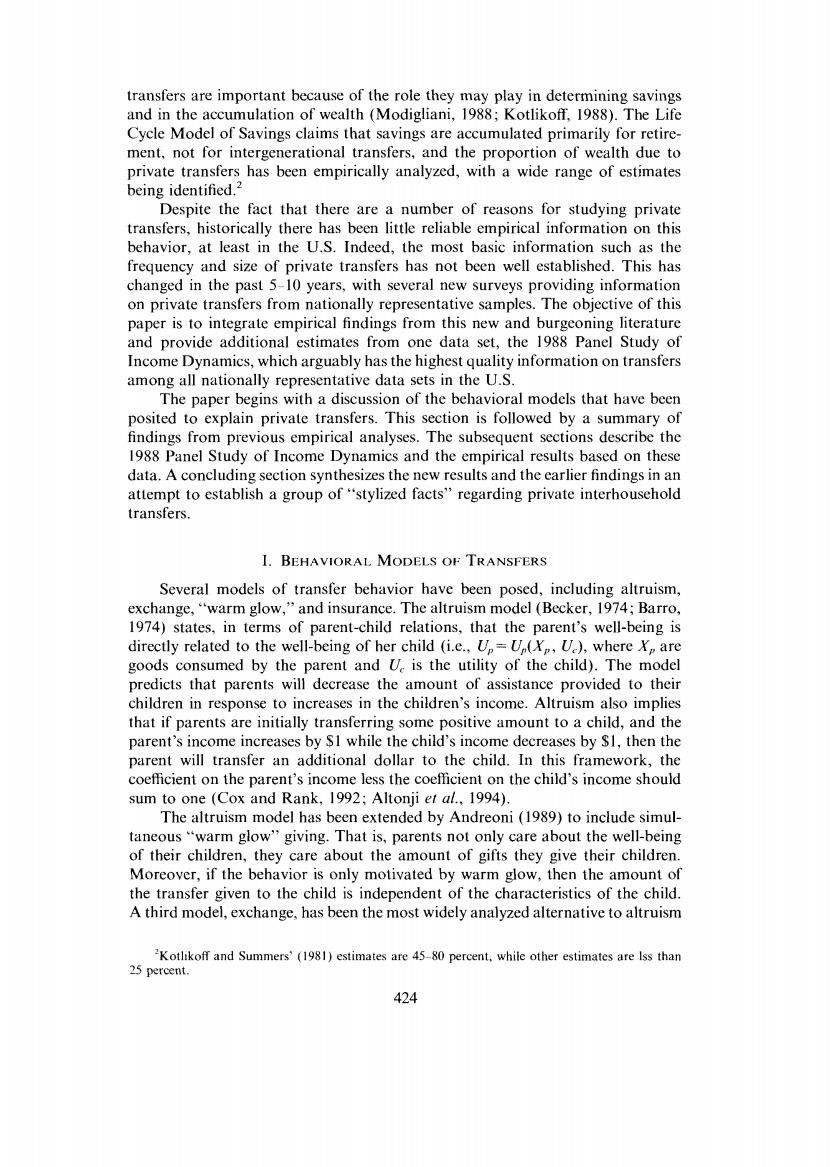正在加载图片...

transfers are important because of the role they may play in determining savings and in the accumulation of wealth (Modigliani,1988;Kotlikoff,1988).The Life Cycle Model of Savings claims that savings are accumulated primarily for retire- ment,not for intergenerational transfers,and the proportion of wealth due to private transfers has been empirically analyzed,with a wide range of estimates being identified.2 Despite the fact that there are a number of reasons for studying private transfers,historically there has been little reliable empirical information on this behavior,at least in the U.S.Indeed,the most basic information such as the frequency and size of private transfers has not been well established.This has changed in the past 5-10 years,with several new surveys providing information on private transfers from nationally representative samples.The objective of this paper is to integrate empirical findings from this new and burgeoning literature and provide additional estimates from one data set,the 1988 Panel Study of Income Dynamics,which arguably has the highest quality information on transfers among all nationally representative data sets in the U.S. The paper begins with a discussion of the behavioral models that have been posited to explain private transfers.This section is followed by a summary of findings from previous empirical analyses.The subsequent sections describe the 1988 Panel Study of Income Dynamics and the empirical results based on these data.A concluding section synthesizes the new results and the earlier findings in an attempt to establish a group of"stylized facts"regarding private interhousehold transfers. 1.BEHAVIORAL MODELS OF TRANSFERS Several models of transfer behavior have been posed,including altruism, exchange,"warm glow,"and insurance.The altruism model (Becker,1974;Barro, 1974)states,in terms of parent-child relations,that the parent's well-being is directly related to the well-being of her child (i.e.,U=U(Y,U),where Y are goods consumed by the parent and U.is the utility of the child).The model predicts that parents will decrease the amount of assistance provided to their children in response to increases in the children's income.Altruism also implies that if parents are initially transferring some positive amount to a child,and the parent's income increases by SI while the child's income decreases by $l,then the parent will transfer an additional dollar to the child.In this framework,the coefficient on the parent's income less the coefficient on the child's income should sum to one (Cox and Rank,1992;Altonji et al.,1994). The altruism model has been extended by Andreoni (1989)to include simul- taneous"warm glow"giving.That is,parents not only care about the well-being of their children,they care about the amount of gifts they give their children. Moreover,if the behavior is only motivated by warm glow,then the amount of the transfer given to the child is independent of the characteristics of the child. A third model,exchange,has been the most widely analyzed alternative to altruism 'Kotlikoff and Summers'(1981)estimates are 45-80 percent,while other estimates are Iss than 25 percent 424transfers are important because of the role they may play in determining savings and in the accumulation of wealth (Modigliani, 1988; Kotlikoff, 1988). The Life Cycle Model of Savings claims that savings are accumulated primarily for retirement, not for intergenerational transfers, and the proportion of wealth due to private transfers has been empirically analyzed, with a wide range of estimates being identified.2 Despite the fact that there are a number of reasons for studying private transfers, historically there has been little reliable empirical information on this behavior, at least in the U.S. Indeed, the most basic information such as the frequency and size of private transfers has not been well established. This has changed in the past 5-10 years, with several new surveys providing information on private transfers from nationally representative samples. The objective of this paper is to integrate empirical findings from this new and burgeoning literature and provide additional estimates from one data set, the 1988 Panel Study of Income Dynamics, which arguably has the highest quality information on transfers among all nationally representative data sets in the U.S. The paper begins with a discussion of the behavioral models that have been posited to explain private transfers. This section is followed by a summary of findings from previous empirical analyses. The subsequent sections describe the 1988 Panel Study of Income Dynamics and the empirical results based on these data. A concluding section synthesizes the new results and the earlier findings in an attempt to establish a group of "stylized facts" regarding private interhousehold transfers. Several models of transfer behavior have been posed, including altruism, exchange, "warm glow," and insurance. The altruism model (Becker, 1974; Barro, 1974) states, in terms of parent-child relations, that the parent's well-being is directly related to the well-being of her child (i.e., U,>= U,(X,, U,), where X, are goods consumed by the parent and U, is the utility of the child). The model predicts that parents will decrease the amount of assistance provided to their children in response to increases in the children's income. Altruism also implies that if parents are initially transferring some positive amount to a child, and the parent's income increases by $1 while the child's income decreases by $1, then the parent will transfer an additional dollar to the child. In this framework, the coefficient on the parent's income less the coefficient on the child's income should sum to one (Cox and Rank, 1992; Altonji et al., 1994). The altruism model has been extended by Andreoni (1989) to include simultaneous "warm glow" giving. That is, parents not only care about the well-being of their children, they care about the amount of gifts they give their children. Moreover, if the behavior is only motivated by warm glow, then the amount of the transfer given to the child is independent of the characteristics of the child. A third model, exchange, has been the most widely analyzed alternative to altruism '~othkoff and Summers' (1981) estimates are 45-80 percent, while other estimates are Iss than 25 percent